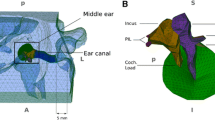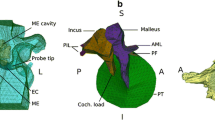Abstract
Ear canal acoustics was examined using a one-dimensional lossy transmission line with a distributed load impedance to model the ear. The acoustic input impedance of the ear was derived from sound pressure measurements in the ear canal of healthy human ears. A nonlinear least squares fit of the model to data generated estimates for ear canal radius, ear canal length, and quantified the resistance that would produce transmission losses. Derivation of ear canal radius has application to quantifying the impedance mismatch at the eardrum between the ear canal and the middle ear. The length of the ear canal was found, in general, to be longer than the length derived from the one-quarter wavelength standing wave frequency, consistent with the middle ear being mass-controlled at the standing wave frequency. Viscothermal losses in the ear canal, in some cases, may exceed that attributable to a smooth rigid wall. Resistance in the middle ear was found to contribute significantly to the total resistance. In effect, this analysis “reverse engineers” physical parameters of the ear from sound pressure measurements in the ear canal.





Similar content being viewed by others
References
Aibara R, Welsh J, Puria S, Goode R (2001) Human middle-ear sound transfer function and cochlear input impedance. Hear Res 152:100–109
Allen J (1986) Measurement of eardrum acoustic impedance. In: Allen JB, Hall JL, Hubbard A, Neely ST, Tubis A (eds) Peripheral auditory mechanisms. Springer, New York, pp 44–51
Bekesy G (1960) Experiments in hearing. McGraw Hill, New York
Benade A (1968) On the propagation of sound waves in a cylindrical conduit. J Acoust Soc Am 44:616–623
Chan J, Geisler C (1990) Estimation of eardrum acoustic pressure and of ear canal length from remote points in the canal. J Acoust Soc Am 87:1237–1247
Coleman T, Li Y (1994) On the convergence of interior-reflective Newton methods for nonlinear minimization subject to bounds. Math Program 67:189–224
Farmer-Fedor B, Rabbitt R (2002) Acoustic intensity, impedance and reflection coefficient in the human ear canal. J Acoust Soc Am 112:600–620
Henry P (1931) The tube effect in sound-velocity measurements. Proc Phys Soc 43:340–362
Huang G, Rosowski J, Puria S, Peake W (2000) Tests of some common assumptions of ear-canal acoustics in cats. J Acoust Soc Am 108:1147–1161
Kaye G, Sherratt G (1933) The velocity of sound in gases in tubes. Proc R Soc A 141:123–143
Keefe D, Simmons J (2003) Energy transmittance predicts conductive hearing loss in older children and adults. J Acoust Soc Am 114:3217–3238
Keefe D, Ling R, Bulen J (1992) Method to measure acoustic impedance and reflection coefficient. J Acoust Soc Am 91:470–485
Kringlebotn M (1994) Acoustic impedance in the human ear canal. Scandanavian Audiology 23:65–71
Kringlebotn M (1988) Network model for the human middle ear. Scand Audiol 17:75–85
Lynch T, Peake W, Rosowski J (1994) Measurements of the acoustic input impedance of cat ears: 10 hz to 20 khz. J Acoust Soc Am 96:2184–2209
Margolis R, Saly G, Keefe D (1999) Wideband reflectance tympanometry in normal adults. J Acoust Soc Am 106:265–280
Moller A (1961) Network model of the middle ear. J Acoust Soc Am 33:168–176
Moller A (1965) An experimental study of the acoustic impedance of the middle ear and its transmission properties. Acta Oto-Laryngologica 60:129–149
O’Connor K, Puria S (2008) Middle-ear circuit model parameters based on a population of human ears. J Acoust Soc Am 123:197–211
Parent P, Allen J (2007) Wave model of the cat tympanic membrane. J Acoust Soc Am 122:918–931
Rabinowitz W (1981) Measurement of the acoustic input immittance of the human ear. J Acoust Soc Am 70:1025–1035
Shields F, Lee K, Wiley W (1965) Numerical solution for sound velocity and absorption in cylindrical tubes. J Acoust Soc Am 37:724–729
Stinson M (1985) The spatial distribution of sound pressure within scaled replicas of the human ear canal. J Acoust Soc Am 78:1596–1602
Stinson M (1990) Revision of estimates of acoustic energy reflectance at the human eardrum. J Acoust Soc Am 88:1773–1778
Voss S, Allen J (1994) Measurement of acoustic impedance and reflectance in the human ear canal. J Acoust Soc Am 95:372–384
Voss S, Rosowski J, Merchant S, Peake W (2000) Acoustic responses of the human middle ear. Hear Res 150:43–69
Voss S, Horton N, Woodbury R, Sheffield K (2008) Sources of variability in reflectance measurements on normal cadaver ears. Ear Hear 29:651–665
Weston D (1953) The theory of the propagation of plane sound waves in tubes. Proc Phys Soc B 66:695–709
Withnell R, Jeng P, Waldvogel K, Morgenstein K, Allen J (2009) An in-situ calibration for hearing thresholds. J Acoust Soc Am 125:1605–1611
Zwislocki J (1962) Analysis of the middle-ear function. part i: Input impedance. J Acoust Soc Am 34:1514–1523
Zwislocki J (1970) An acoustic coupler for earphone calibration (Tech. Rep. No. LSC-S-7). Syracuse University
Acknowledgments
Robert Withnell is indebted to the School of Mechanical Engineering at The University of Western Australia for generously hosting his sabbatical and for the award of a Gledden Senior Research Fellowship that provided the impetus for this work. Doug Keefe, Mead Killion, and one anonymous reviewer, provided valuable feedback and advice on earlier versions of this paper. Portions of this paper were presented at the Mechanics of Hearing 2011 conference in Williamstown, MA, USA and the American Auditory Society conference in Scottsdale, AZ, USA.
Author information
Authors and Affiliations
Corresponding author
Rights and permissions
About this article
Cite this article
Withnell, R.H., Gowdy, L.E. An Analysis of the Acoustic Input Impedance of the Ear. JARO 14, 611–622 (2013). https://doi.org/10.1007/s10162-013-0407-y
Received:
Accepted:
Published:
Issue Date:
DOI: https://doi.org/10.1007/s10162-013-0407-y




